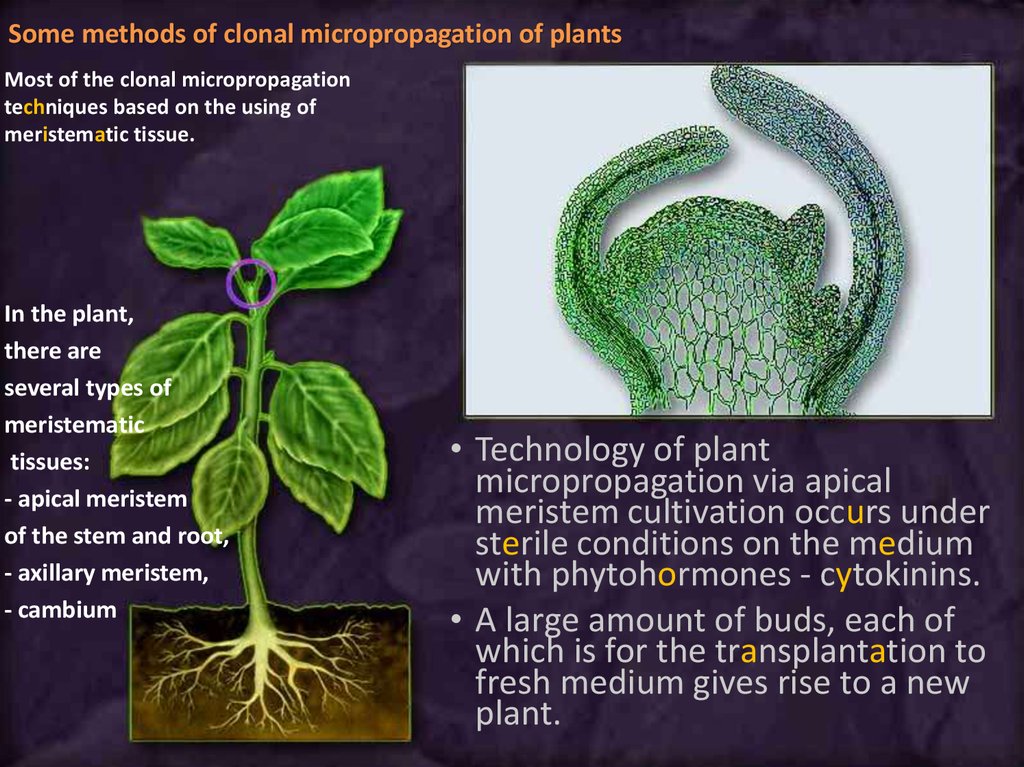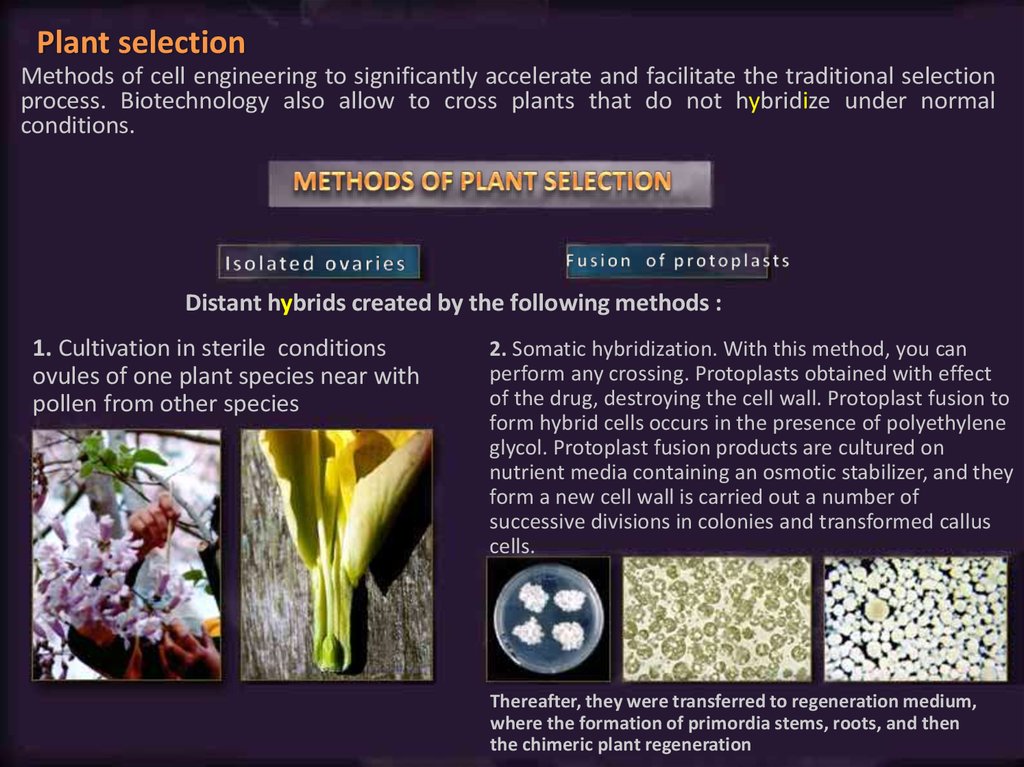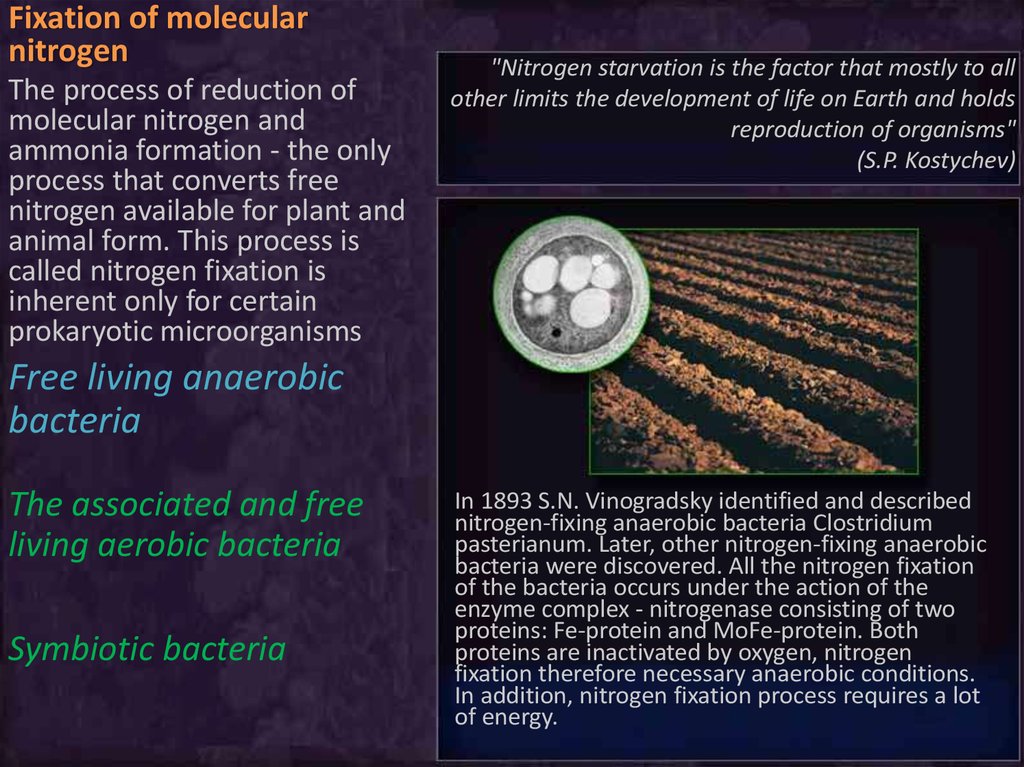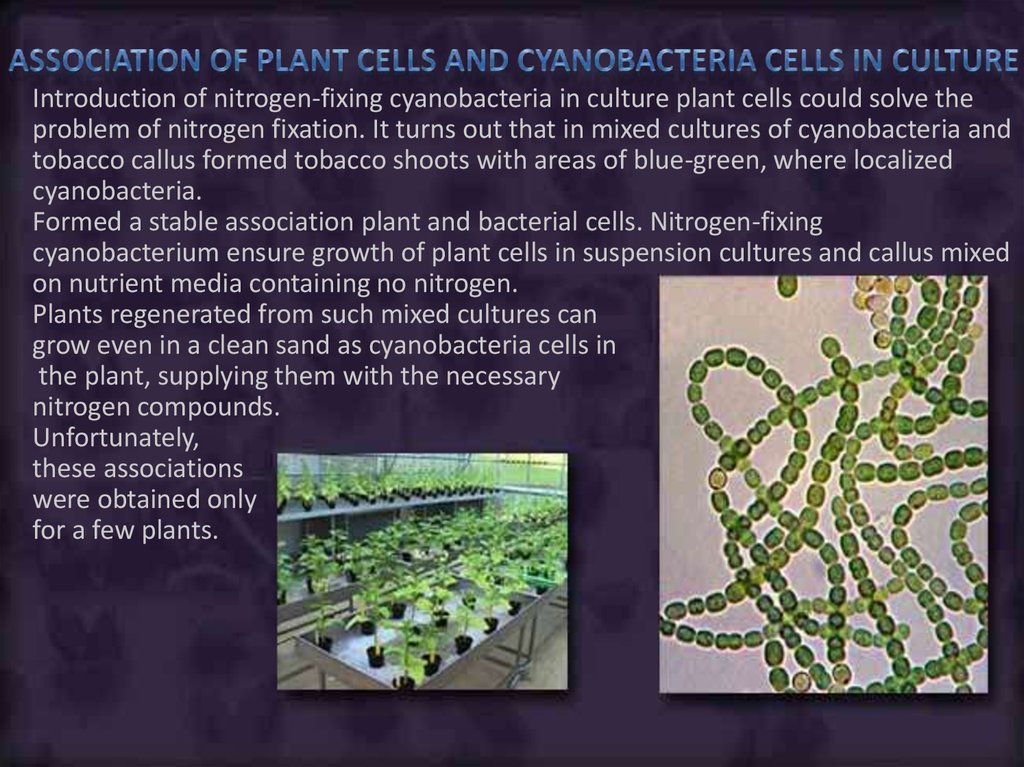Похожие презентации:
Biotechnology in agriculture
1.
2. Clonal micropropagation
One of the main features of live organisms – the ability to reproduce. There are two main ways ofreproduction: syngenesis (sexual reproduction) and agamobium (asexual reproduction ). For each of
them characterized a considerable variety of forms.
WAYS OF REPRODUCTION
AGAMOBIUM
SYNGENESIS
VEGETATIVE
CLONAL
Syngenesis – reproduction at which the new organism
develops from zygotes, formed as a result
fertilisations, i.e. merges of male and female sex cells
3. Clonal micropropagation
One of the main features of live organisms – the ability to reproduce. There are two main ways ofreproduction: syngenesis and agamobium. For each of them characterized a considerable variety of
forms.
WAYS OF REPRODUCTION
AGAMOBIUM
SYNGENESIS
VEGETATIVE
CLONAL
Agamobium is characterized by the absence of
sexual reproduction; such reproduction is peculiar
for unicellular and multicellular plants and animals.
4. Clonal micropropagation
One of the main features of live organisms – the ability to reproduce. There are two main ways ofreproduction: syngenesis and agamobium. For each of them characterized a considerable variety of
forms.
WAYS OF REPRODUCTION
AGAMOBIUM
SYNGENESIS
VEGETATIVE
Vegetative propagation
CLONAL
– formation of new organism
from part of maternal. Thus, the microorganisms almost all
plants and some animals (sponges, bryozoans,
coelenterates, protozoa) can multiply .
5. Clonal micropropagation
One of the main features of live organisms – the ability to reproduce. There are two main ways ofreproduction: syngenesis and agamobium. For each of them characterized a considerable variety of
forms.
WAYS OF PROPAGATION
AGAMOBIUM
SYNGENESIS
VEGETATIVE
CLONAL
Clonal micropropagation is also used for rapid
production of large amounts of virus-free
planting material further into the ground.
6. Application of clonal micropropagation in plant growing
The term "clone" (Greek Klon - stalk) was proposed in 1903 Webber for vegetatively propagated plants. It is
expected that the offspring of plants propagated asexually, only a part (clones) of the parent individual,
identical to her and to each other. Cloning involves organisms derived from single cells by miotic division.
Clonal micropropagation - is using of “in vitro” technology for rapid asexual propagation of plants that are
identical to the original.
For mass production of rehabilitated plant is
necessary to fast clonal micropropagation of new
and existing varieties become a large-scale
process.
Among the plants for the first time this method
is applied for the reproduction of Orchids. Now,
as propagated by many decorative plants.
Micropropagation allows to obtain from one lily
bulb variety of «Red Carpet» to 105 new plants
for 6 months. Most roses are sold in flower
shops, obtained by cloning. One plant of gerbera
in a year gives up to one million new genotypic
and phenotypic similarities plants by clonal
micropropagation. In conventional reproduction
methods there can obtain only 50 - 100 plants.
7. Application of clonal microreproduction in plant growing
The term "clone" (Greek Klon - stalk) was proposed in 1903 Webber for vegetatively propagated plants. It isexpected that the offspring of plants propagated asexually, only a part (clones) of the parent individual, identical to
her and to each other. Cloning involves organisms derived from single cells by miotic division.
Clonal micropropagation - is using of “in vitro” technology for rapid asexual production of plants that are identical
to the original.
In selection clonal micropropagation
is used to preserve in culture of the
new promising varieties which are
especially received in vitro
The required number of copies for a
breeder's unique genotype does not
require large scale. Periodically
mikroshanks’, microtubers’, or other
plant organs’ transplanting on a
fresh culture medium. The plants
can be cultivate for a long time in
vitro with the necessary genotype.
8. Application of clonal microreproduction in plant growing
The term "clone" (Greek Klon - stalk) was proposed in 1903, Webber for vegetatively propagated plants. Assumedthat the offspring of plants propagated asexually, only a part (clones) of the parent individual, identical to her and
to each other. Cloning involves organisms derived from single cells by miotic division.
Clonal micropropagation - is the use of technology "in vitro" for rapid asexual production of plants that are
identical to the original.
Clonal micropropagation is also used for
rapid production of large amounts of
virus-free planting material.
The plants received from meristems in
many cases are free from viruses. Clonal
propagation of such plants and their
testing for absence of viruses allowed to
receive the revitalized planting stock. So
multiple copies are propagated the
valuable varieties of potato, wild
strawberry, lilies relieved of viral
infection.
9. Application of clonal microreproduction in plant growing
The term "clone" (Greek Klon - stalk) was proposed in 1903, Webber for vegetativelypropagated plants. Assumed that the offspring of plants propagated asexually, only a part
(clones) of the parent individual, identical to her and to each other. Cloning involves organisms
derived from single cells by miotic division. Clonal micropropagation - is the use of technology
"in vitro" for rapid asexual production of plants that are identical to the original.
Clonal micropropagation helps
in preserving of
rare and
endangered plant species.
The technology of reproduction
of rare plants and their return
to natural ecosystems still
needs developing.
10. Application of clonal microreproduction in plant growing
The term "clone" (Greek Klon - stalk) was proposed in 1903, Webber for vegetativelypropagated plants. Assumed that the offspring of plants propagated asexually, only a part
(clones) of the parent individual, identical to her and to each other. Cloning involves organisms
derived from single cells by miotic division. Clonal micropropagation - is the use of technology
"in vitro" for rapid asexual production of plants that are identical to the original.
Clonal micropropagation is also used to
speed up the breeding and selection of
woody plants.
In Italy, thanks to graftage axillary shoots in
vitro, for the year more than a million grown
rootstocks of peach trees. Likewise cloned
Guinean oil palm, many breeds of
coniferous trees (spruce, pine, larch,
redwood). By using clonal propagation of
certain specimens of adult plants manage to
create decorative woody plants with
unusual shapes and colors, such spruce as a
bowl, "weeping" of golden color, etc.
11.
Technology of clonal micropropagationFor the clones may be used any cell, tissue or plant organ. Stimulation consistently dedifferentiation of
cells and secondary explant differentiation of callus cells can be achieved plant regeneration. However,
easier and more convenient to use for cloning meristematic tissues, because they have genetic stability
and lead to the improvement of the plants.
Implement totipotency in vitro can be possible by induction in the callus tissue
or cultured cells chain facts. This formation of meristematic (hearth) foci;
development based on them rudiments of stem apex;
appearance of the shoots that after rooting
develop into a whole plant
(induction of shoots).
It is necessary to receive
well growing sterile culture
in which on 1 exsplant (leaf
piec) large number of buds
are formed.
12.
Technology of clonal micropropagationFor the clones may be used any cell, tissue or plant organ. Calling consistently dedifferentiation of cells and
secondary explant differentiation of callus cells can be achieved plant regeneration. However, easier and
more convenient
to use for cloning meristematic tissues, because they have genetic stability and lead to the rehabilitation
of the plant. Implement totipotency in vitro can be possible by induction in the callus tissue
or cultured cells chain facts. This formation of meristematic foci;
development based on them rudiments of stem apex;
appearance of the shoots that after rooting
develop into a whole plant
(induction of shoots).
During the multiplication of
the received culture the
buds are separated from the
explant and planted in a new
culture medium, where it
takes root and grows
13.
Technology of clonal microreproductionFor the clones may be used any cell, tissue or plant organ. Calling consistently dedifferentiation of cells and
secondary explant differentiation of callus cells can be achieved plant regeneration. However, easier and
more convenient
to use for cloning meristematic tissues, because they have genetic stability and lead to the rehabilitation
of the plant. Implement totipotency in vitro can be possible by induction in the callus tissue
or cultured cells chain facts. This formation of meristematic foci;
development based on them rudiments of stem apex;
appearance of the shoots that after rooting
develop into a whole plant
(induction of shoots).
To rooting shoots adapted to
the soil conditions, it is
necessary to maintain a
certain humidity (creation of
a "fog"), temperature, etc.
14.
Technology of clonal microreproductionFor the clones may be used any cell, tissue or plant organ. Calling consistently dedifferentiation of cells and
secondary explant differentiation of callus cells can be achieved plant regeneration. However, easier and
more convenient
to use for cloning meristematic tissues, because they have genetic stability and lead to the rehabilitation
of the plant. Implement totipotency in vitro can be possible by induction in the callus tissue
or cultured cells chain facts. This formation of meristematic foci;
development based on them rudiments of stem apex;
appearance of the shoots that after rooting
develop into a whole plant
(induction of shoots).
• The plants taken
from vessels are
grown up in the soil
15.
Somatic embryogenesisFrom somatic cells or callus cells at certain culture medium may be formed like the
embryo structures - embryos. Consistently passing certain stages of development,
somatic embryos can form in seedlings. This eliminates the step of rooting, which
facilitates and accelerates the process of cloning.
Not orderly growing cages
16.
Somatic embryogenesisFrom somatic cells or callus cells at certain culture medium may be formed like the
embryo structures - embryos. Consistently passing certain stages of development,
somatic embryos can form in seedlings. This eliminates the step of rooting, which
facilitates and accelerates the process of cloning.
Heart-shaped germs
17.
Somatic embryogenesisFrom somatic cells or callus cells at certain culture medium may be formed like the
embryo structures - embryos. Consistently passing certain stages of development,
somatic embryos can form in seedlings. This eliminates the step of rooting, which
facilitates and accelerates the process of cloning.
Germs in stage of "Torpedo"
18.
Somatic embryogenesisFrom somatic cells or callus cells at certain culture medium may be formed like the
embryo structures - embryos. Consistently passing certain stages of development,
somatic embryos can form in seedlings. This eliminates the step of rooting, which
facilitates and accelerates the process of cloning.
Young seedlings
19.
Somatic embryogenesisFrom somatic cells or callus cells at certain culture medium may be formed like the
embryo structures - embryos. Consistently passing certain stages of development,
somatic embryos can form in seedlings. This eliminates the step of rooting, which
facilitates and accelerates the process of cloning.
Adaptation rooted
shoots to soil conditions
20.
Somatic embryogenesisFrom somatic cells or callus cells at certain culture medium may be formed like the
embryo structures - embryos. Consistently passing certain stages of development,
somatic embryos can form in seedlings. This eliminates the step of rooting, which
facilitates and accelerates the process of cloning.
Cultivation of plants in the soil
extracted from vessels
21.
Adaptation of grapesSimplified cheapest way to adapt grape plants grown in sterile
conditions in test tubes, it was developed at the Institute of Physiology
of plants named after K.A. Timiryazev Academy of Sciences. Adaptation
is carried out directly in the test tubes. When the plants grow up to tops
their removed from its tubes.
After 1.5 - 2 weeks, when the shoots appear above the tops of test
tubes, the plants are ready for transplanting into the soil.
22. Some methods of clonal micropropagation of plants
Most of the clonal micropropagationtechniques based on the using of
meristematic tissue.
In the plant,
there are
several types of
meristematic
tissues:
- apical meristem
of the stem and root,
- axillary meristem,
- cambium
• Technology of plant
micropropagation via apical
meristem cultivation occurs under
sterile conditions on the medium
with phytohormones - cytokinins.
• A large amount of buds, each of
which is for the transplantation to
fresh medium gives rise to a new
plant.
23.
• Most often, the development of axillarymeristems are activated by removing the
shoot apical meristem, course plant
hormones produced by the apical
meristem, axillary meristems hinder
development. At removing the apical
meristems of axillary buds shoots are
formed, which are propagated by cuttings
and transplanted to a new culture medium
for rooting.
24.
• Neoplasm meristem in the stem ofthe plant is possible at injury. The
dedifferentiation of cells is returned
them to a state similar to
embryonic. The cells again acquire
the ability to divide. Vegetative
propagation of plants on this ability
is based.
25.
The shoot apical meristem (SAM) givesrise to organs like the leaves and flowers,
while the root apical meristem (RAM)
provides the meristematic cells for the
future root growth.
• Root apical meristem is different
from stem apical meristem in that
initial cells are divided itself very
rare, making quiescent center. The
meristem volume is increased
through derivatives. Intensive
division quiescent center cells
occurs under the influence of
mutagenic agents, radiation, etc.
26. Improvement of plants
• Because of viral disease 10 to 50% of theyield of agricultural plants are die.
Viruses spread rapidly conducting
system of plants. There is no conducting
system in meristem, so the cells of
meristematic tissue of plants usually do
not contain viruses. While growing the
apical meristem with 2-3 leaf primordia
can obtain genetically homogeneous
virus-free plants in large numbers.
But at the same time than larger size
tissue fragments, the easier from it is
produced a plant although the
probability of its presence in the tissues
is increased.
In some cases for destruction of infection has
to expose plants heat or chemical treatment,
and only then to allocate meristem and to get
of them healthy plant-regenerants.
27. Plant selection
Methods of cell engineering to significantly accelerate and facilitate the traditional selectionprocess. Biotechnology also allow to cross plants that do not hybridize under normal
conditions.
Distant hybrids created by the following methods :
1. Cultivation in sterile conditions
ovules of one plant species near with
pollen from other species
2. Somatic hybridization. With this method, you can
perform any crossing. Protoplasts obtained with effect
of the drug, destroying the cell wall. Protoplast fusion to
form hybrid cells occurs in the presence of polyethylene
glycol. Protoplast fusion products are cultured on
nutrient media containing an osmotic stabilizer, and they
form a new cell wall is carried out a number of
successive divisions in colonies and transformed callus
cells.
Thereafter, they were transferred to regeneration medium,
where the formation of primordia stems, roots, and then
the chimeric plant regeneration
28.
Fixation of molecularnitrogen
The process of reduction of
molecular nitrogen and
ammonia formation - the only
process that converts free
nitrogen available for plant and
animal form. This process is
called nitrogen fixation is
inherent only for certain
prokaryotic microorganisms
"Nitrogen starvation is the factor that mostly to all
other limits the development of life on Earth and holds
reproduction of organisms"
(S.P. Kostychev)
Free living anaerobic
bacteria
The associated and free
living aerobic bacteria
Symbiotic bacteria
In 1893 S.N. Vinogradsky identified and described
nitrogen-fixing anaerobic bacteria Clostridium
pasterianum. Later, other nitrogen-fixing anaerobic
bacteria were discovered. All the nitrogen fixation
of the bacteria occurs under the action of the
enzyme complex - nitrogenase consisting of two
proteins: Fe-protein and MoFe-protein. Both
proteins are inactivated by oxygen, nitrogen
fixation therefore necessary anaerobic conditions.
In addition, nitrogen fixation process requires a lot
of energy.
29.
"Nitrogen starvation is the factor that mostly to allother limits the development of life on Earth and holds
reproduction of organisms"
(S.P. Kostychev)
Free living anaerobic
bacteria
The associated and free
living aerobic bacteria
Symbiotic bacteria
Apart from clostridia live in the soil nitrogen-fixing
aerobic bacteria of the genus Fyascheschifseuk , soil
cyanobacteria, and archaebacteria and some other
groups of bacteria, and in the rivers, lakes, seas,
nitrogen fix some photosynthetic bacteria. To
nitrogenase enzyme complex is not inactivated by
oxygen, they are placed in special organelles
(cyanobacteria), or in special cells with very dense
shell (Azotobacter). Considered promising increase
nitrogen fixation activity of the bacteria genus
Azospirilla, associated with cereals, and the
establishment of closer ties between them.
30.
"Nitrogen starvation is the factor that mostly to allother limits the development of life on Earth and holds
reproduction of organisms"
(S.P. Kostychev)
Free living anaerobic
bacteria
The associated and free
living aerobic bacteria
Symbiotic bacteria
In ancient times, the nitrogen-fixing symbiosis
between fungi and cyanobacteria led to the
formation of lichens. In our time, the most active
nitrogen fixers considered nodule bacteria of the
genus Rizobium, forming nodules on the roots, in
symbiosis with leguminous plants. There are other
examples of symbiotic nitrogen fixation, such as
nodules on the roots of alder (formed by it in
symbiosis with actinomycetes genus Frankia).
Some tropical plants form nodules on the leaves,
such as cyanobacteria Azolla fern and tropical plant
Gunnera
31. Association of plant cells and cyanobacteria cells in culture
Introduction of nitrogen-fixing cyanobacteria in culture plant cells could solve theproblem of nitrogen fixation. It turns out that in mixed cultures of cyanobacteria and
tobacco callus formed tobacco shoots with areas of blue-green, where localized
cyanobacteria.
Formed a stable association plant and bacterial cells. Nitrogen-fixing
cyanobacterium ensure growth of plant cells in suspension cultures and callus mixed
on nutrient media containing no nitrogen.
Plants regenerated from such mixed cultures can
grow even in a clean sand as cyanobacteria cells in
the plant, supplying them with the necessary
nitrogen compounds.
Unfortunately,
these associations
were obtained only
for a few plants.
32. Some methods that increase plant productivity
INTRODUCTION OF CHLOROPLASTSThe introduction of highly chloroplasts
of some plants in isolated protoplasts
others can contribute to the activation of
photosynthesis and increase the
productivity of the past
ASSOCIATIONS WITH CYANOBACTERIA
Photosynthetic cyanobacteria can form
associations with plant cells in culture in vitro and
these cells are provided with carbohydrates.
When using the culture media in which no sugar
and, consequently, no carbohydrate sources, it
appears that the growth of plant cells in culture
can be achieved by mastering plant
photosynthesis products cyanobacteria cells
































 Промышленность
Промышленность








